Back to Luxor and the Nile
- decourcy4
- Nov 28, 2023
- 7 min read
Updated: Dec 2, 2023
Let’s see, what did I leave out? I got as far as Karnak Temple in Luxor. After that, on the same evening, we went to Luxor Temple. The next day, we went to Valley of the Kings, the mortuary temple of Queen Hatshepsut, the Colossi of Memnon, an alabaster factory, and then back to the boat by 1:30, to begin the trip up the Nile. By up the Nile, I mean we were going upriver, against the current. But we were traveling south, from Luxor to Aswan. It could get a little confusing at times.
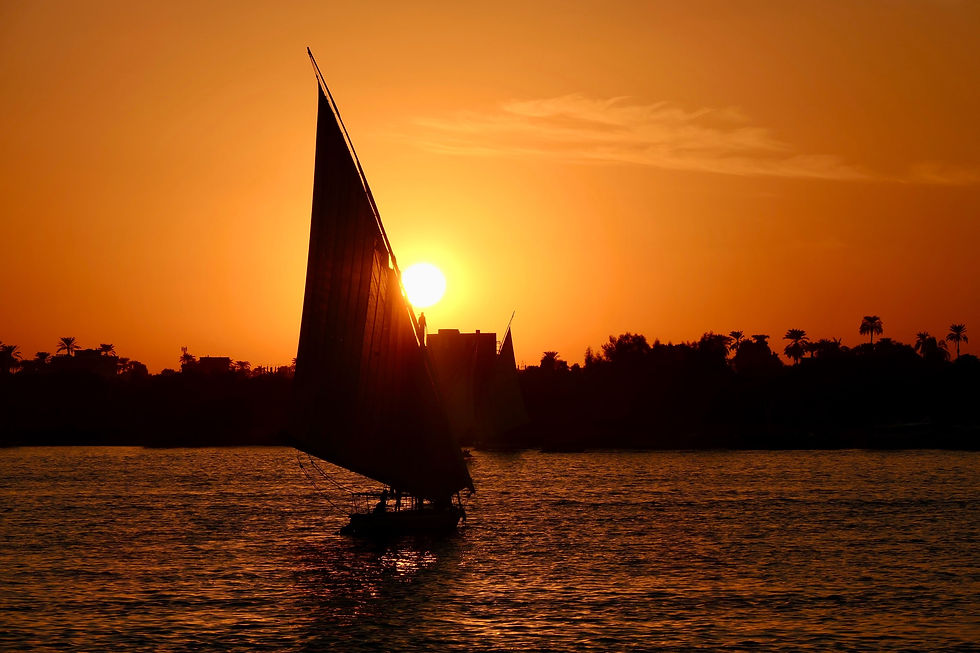
We were on the ship for 4 nights, but we really sailed for two and a half days. We boarded the first day after seeing Karnak Temple and the Luxor Museum and slept docked in Luxor that night. We sailed in early afternoon on day two, and sailed through the night and all the next day. Late on the third day, we docked for a few hours to visit Kom-Ombo, then sailed on to Aswan, arriving around 11 PM. We slept that night and night 4 docked in Aswan. While we were sailing, Lynn and I kept our window wide open and it was lovely, despite the river pirates. The first night on the ship, we had our windows open when another ship docked beside us (I think I wrote about this) and suddenly there was another ship window feet from our own!
But the ship was fun. We saw so many things we wouldn’t have seen otherwise, like all the agriculture, and the pumps pulling water from the Nile for the crops. There were islands and animals (and some birds). There were some lovely sunsets, and apparently, a lovely sunrise that Lynn and I missed. The top floor had an enclosed lounge and bar (location for the evening events like the Egyptian party and the Nubian show), and an outdoor seating area and bar, which was the location of afternoon tea. It also housed a small tent in the corner that was the place for massages. I did have a massage there, and it was slightly odd to be having a massage just feet away from the other passengers…but it was a good massage! The top deck was all lounge chairs and a small pool, and we spent a lot of time up there, watching the land slide by.
We had 3 meals a day on the ship, all buffet style, and a waiter that brought us drinks and cleared our plates. We had the same waiter for the whole trip. We had two tables labeled Trafalgar where we had to sit. Interestingly, Mohamed was not allowed to sit with us—he had another table across the room with the other tour directors. His cabin was also below deck, with no window. The food was good, some parts better than others. The dessert selections were usually wonderful, especially on Egyptian night, when I overdosed on pastries. There were salads and cheeses, two soups, a great assortment of bread and rolls, a pasta station (where sauce could be either “white” or “red”), 2–3 meats/fish, vegetables—we did not go hungry! There was also a separate station with a very nice entree, from lovely sea bass to roast beef to leg of lamb. Water, coffee, and tea were included. Everything else was a separate charge. I spent a lot of 60 Egyptian pounds (about US$2) on bottles of sparkling water. I have already related the (not)-Cabernet incident, which cost the three of us about US$30.
It was, after all, a cruise ship of a sort, so of course we got the obligatory animals made out of towels each day.
The two special events were the Egyptian party, at which passengers dressed up in strange “Egyptian” costumes, mostly purchased from the gift shop on the ship. (At least the items were cheap.) I did not dress up. I walked into the lounge, sat in the loud noise for 2 minutes, and said, that’s it! I went to the cabin to watch the water slide by instead. The other special event was a show put on by Nubian men. Some of it was dancing and singing, and I enjoyed it! Then they started dragging us out to dance too. I actually enjoyed it, and it was a workout! Maybe I’ll include a picture. Or not.
We were supposed to tip US$10/day while we were on the ship, and that money would be divided between the different departments. We could also tip individually as well, and I gave our waiter a couple of bucks and left some money for the room cleaning men. I think I mentioned that the entire crew, from laundry men to kitchen staff, were all men. What Mohamed said was that no family would want their wives and daughters sleeping away from the home. Also I asked him if these jobs on the ship were considered good jobs, and he said no, just adequate.
But, back to the sights! After Karnak Temple and Luxor Museum, we went to the boat and relaxed until 5 PM. The cabin was quite large, more like a motel room than a cruise ship cabin. At 5, we met up and headed to Luxor Temple. Here's the thing—it was literally across the street from where the boat (ship? I've never understood the difference) was docked. But they loaded us on a bus and drove us there, to an entrance on the opposite side from the Nile. I didn't understand why we didn't just walk across, as we could have walked down the sidewalk and crossed the street and been at the same location. I finally think I understand it though. Remember what I've said about traffic here and the lack of rules? While we were under Trafalgar's care, on their excursions, we never crossed a highway or street. I don't remember even crossing a small one with the group. I guess Egyptian traffic vs pedestrians was too high risk for them, and I actually understand that.
Anyway, we arrived at the Temple right around sunset, and the crescent moon was in the sky.

It was a nice temple with some statues and carvings, and a very nice obelisk, but, honestly, we were all fading at this point. We had been up since 3 AM. One annoying thing here, especially around the obelisk, was that the guides all used laser pointers as they talked to their groups, so every time I tried to get a photo, I ended with a bright green dot in the middle of it!
But I did get some nice pictures.
Next, it was back to the ship for dinner, then we went to sleep!
We were up early the next morning for our trip to the Valley of the Kings. As I said, never complain on a guided tour when your guide wants you to get to a location early, before the crowds. It is always worth it.
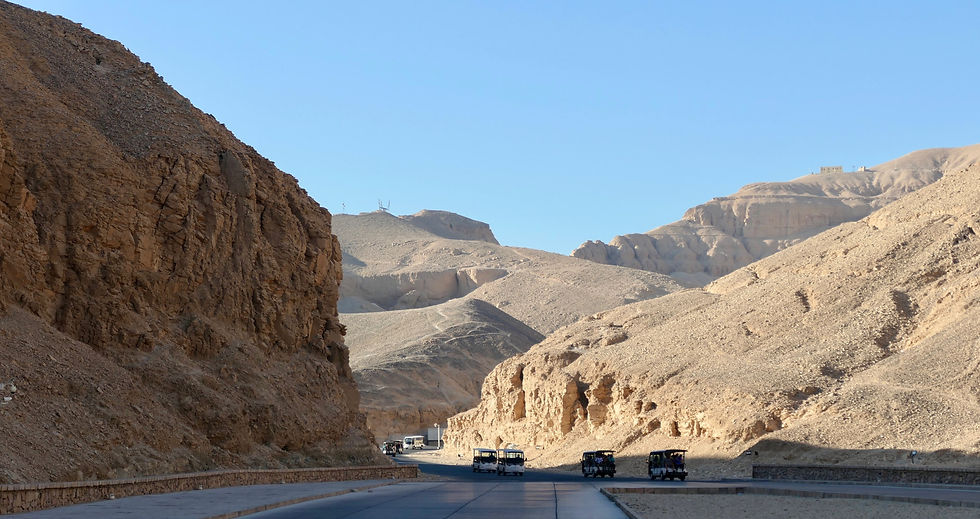
We got off the bus and rode golf carts up the valley. From there we walked and visited four different tombs. We had tickets for three tombs, and most of us also paid the extra to visit the tomb of King Tut (the pharaoh Tutankhamun). There are 65 known tombs in the valley, ranging from simple to one with 120 chambers in the tomb. The ones we visited ranged from ornate, with several hundred feet of tunnels all covered with heiroglyphs to one that was unfinished, with heiroglyphs only near the entrance and rough-cut walls the rest of the way to the tomb. I discovered a fascination with heiroglyphs, and took many many pictures of them over the following week.

The art in the tombs was breathtaking, and I couldn't believe that the colors had lasted all these millennia. I've got to do a couple more large pictures. These are all from the tomb of Rameses IX.



Next up was the tomb of Tutankhamun. Mohamed told us to hurry there, as there was almost no one else down there. And we did have the tomb almost to ourselves. It was a surprisingly small tomb, especially when you consider all that was found in it. (The huge golden sargophagus and all the golden grave goods that we would see in the museum in Cairo were found here.) Interestingly, his mummy was also here, but I chose not to photograph that. The art in the burial chamber was impressive though. I took a video of it.
From there we walked further up the valley and the sun was getting hot. There were a fair number of people around now, but still a fraction of the number that would be there later in the day. It was still before 9 AM.
I got a kick out of this sign.

Next up was Siptah. This was a very large tomb, but was the unfinished tomb I mentioned. The beginning had lots of art, then it just stopped. I guess he died, and they figured why bother doing more for a pharaoh who was already dead.

The final tomb was that of Rameses IV. By now, it was getting pretty crowded. In the tunnels, most of the art was protected, but it was not so further down and in the tombs. I was disturbed at how many people touched the walls and the art.
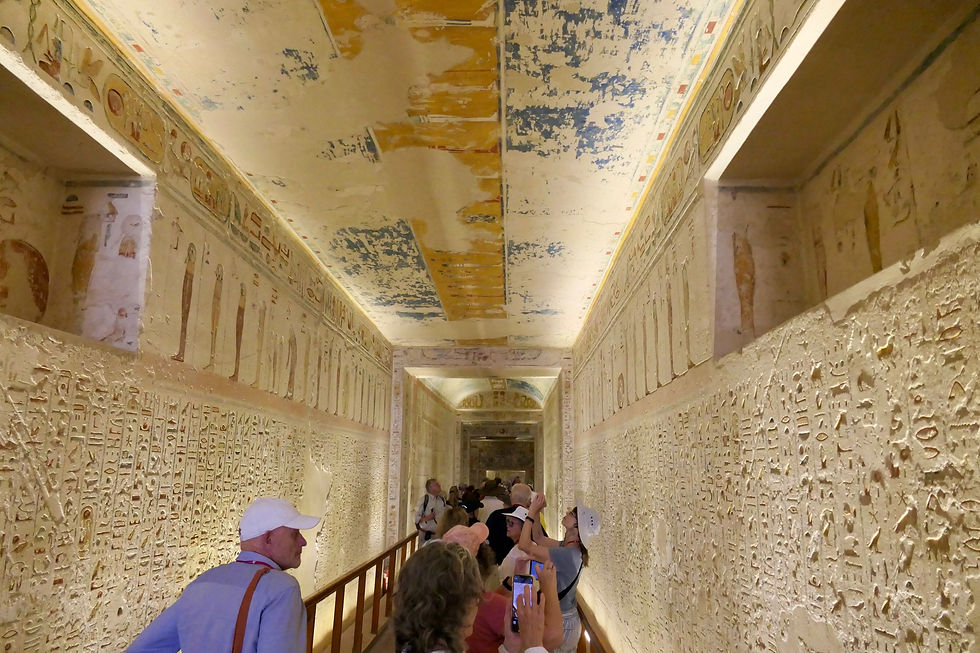
Again, the colors and the sheer volume of art was overwhelming.

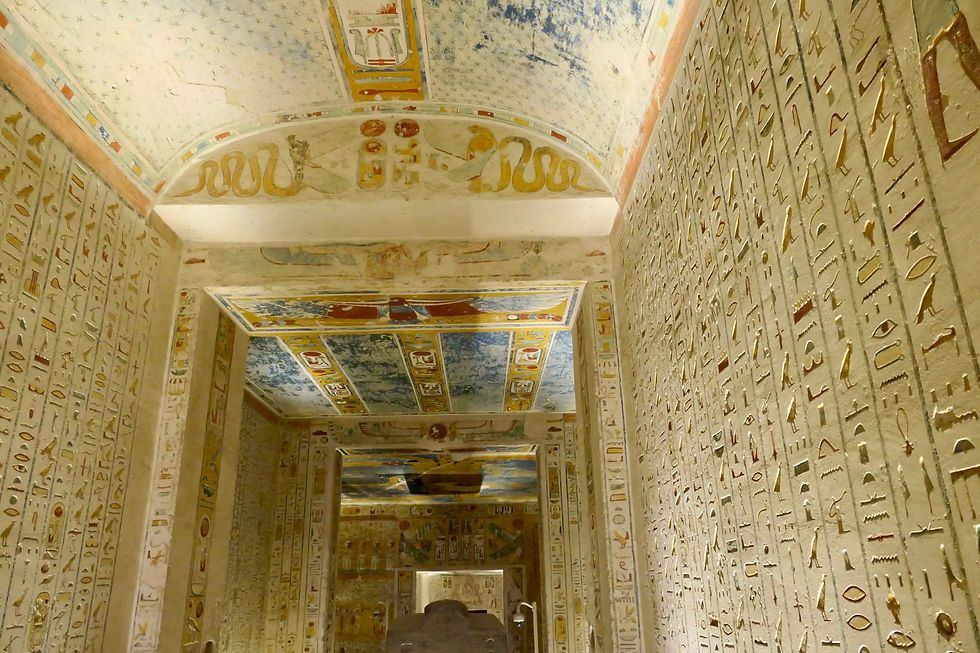
There were other tombs open to the public, but we really saw enough. It was getting hot and much more crowded, so we headed down the valley and back to our bus.
The next stop was the mortuary temple of Queen Hatshepsut. It was not too far from the Valley of the Kings, and they were excavating a lot of other tombs in the area. The new excavations can be seen at the end of this video.
The temple was interesting and different from the closed in tombs that we had visited.
From there, we visited an alabaster factory, where they showed us how they work with alabaster, then try to sell us things. As you probably already know, this is not my favorite kind of stop.
Then, it was back to the boat for our 1:30 PM sailing. It was fun to be underway!













































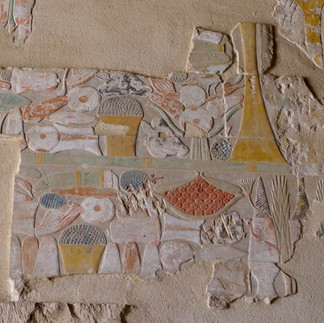











Comments